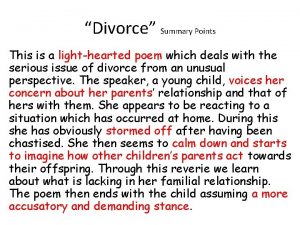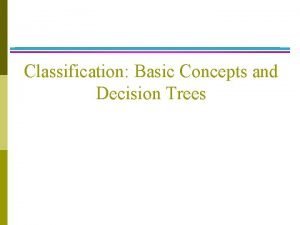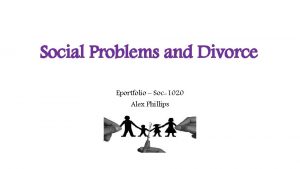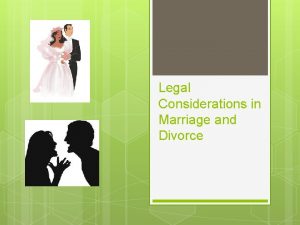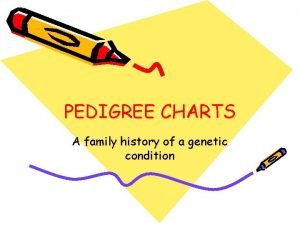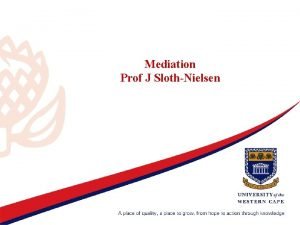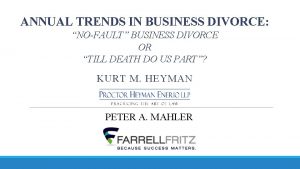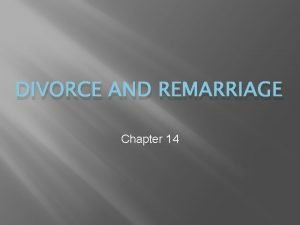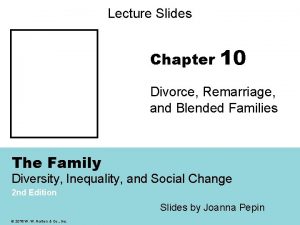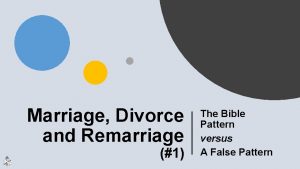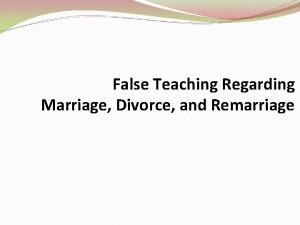CHAPTER 15 Divorce and Remarriage Chapter 15 Divorce







































- Slides: 39

CHAPTER 15 Divorce and Remarriage

Chapter 15: Divorce and Remarriage Introduction • In a sample of 2, 922 undergraduates, 26% reported that their parents were divorced. • Discussion: – Why do people get divorced? What are factors that might lead to divorce? What are potential advantages and disadvantages to divorce? – – – http: //tedxtalks. ted. com/video/Surviving-Divorce-David-Sbarra; search%3 Adivorce http: //tedxtalks. ted. com/video/TEDx. UCSB-Tamara-D-Afifi-The-Imp; search%3 Adivorce http: //www. youtube. com/watch? v=c. Kc. Nyf. Xb. Qz. Q

Chapter 15: Divorce and Remarriage Chapter Outline • • • Divorce Micro Factors Contributing to Divorce Consequences of Divorce for Spouses/Parents Consequences of Divorce for Children Conditions of a “Successful” Divorce Remarriage Stepfamilies Children in Stepfamilies Developmental Tasks for Stepfamilies The Future of Divorce and Remarriage

Divorce • Legal ending of a valid marriage contract • Characteristics that appear to affect divorce rates: – Education and Age – Race – Religion – Previous Marriage – http: //www. cdc. gov/nchs/nvss/marriage_divor ce_tables. htm

Divorce by Occupations • High- and Low-Risk Occupations for Divorce – Highest: dancer/choreographer (43%) – Bartender (38%) – Lowest: optometrist (4%) – Next lowest: clergy (5%) – Other notable divorce rates: nurses (29%), sociologists (23%), authors/teachers (15%)

Ending an Unsatisfactory Relationship • Before ending a relationship, consider the following: – Reviving and improving the relationship – Acknowledge and accept that terminating a relationship will be difficult and painful – In talking with your partner, blame yourself for the end – Cut off the relationship completely – Learn from the terminated relationship – Allow time to grieve over the end of the relationship – Clean your Facebook page

Macro Factors Contributing to Divorce • Increased Economic Independence of Women • Changing Family Functions and Structure • Liberal Divorce Laws • Fewer Moral and Religious Sanctions • More Divorce Models • Mobility and Anonymity • Ethnicity and Culture

Micro Factors Contributing to Divorce • • • Differences Falling Out of Love Limited Time Together Decrease in Positive Behavior Affair Lack of Conflict Resolution Skills Value Changes Satiation Perception that One Would Be Happier if Divorced

Divorce in Other Cultures http: //www. youtube. com/watch? v=qs 9 XSTt-DIE

Divorce in Other Countries

Divorce: Top 30 Factors 1. 2. 3. 4. Courtship of less than two years Having little in common Marrying at 17 or younger Differences in race, education, age, religion, social class, values, and libido 5. Not being religiously devout 6. A cohabitation history with different partners 7. Previous marriage 8. No children 9. Limited education 10. Urban residence

Divorce: Top 30 Factors 11. Infidelity 12. Divorced parents 13. Poor communication skills 14. Unemployment of husband 15. Employment of wife 16. Mental or physical disability 17. Having seriously ill child 18. Low self-esteem of spouses 19. Being African American 20. Lack of commitment

Divorce: Top 30 Factors 21. 22. 23. 24. 25. 26. 27. 28. 29. 30. Experiencing rape Having premarital pregnancy or unwanted child Stepchildren High debt or sudden loss of income Experiencing violence or abuse Having parents who never married Marrying someone who has been divorced Wife earns higher income than husband Falling out of love Bankruptcy *The more factors, the more likely a couple will divorce*

Consequences of Divorce for Spouses/Parents • Women are significantly more likely than men to report that they initiated the breakup • Men reported more difficulty than women did in adjusting to a breakup • The passage of time and involvement with a new partner were identified as the most helpful factors in getting over a love relationship that ended

Financial Consequences Who suffers more financially? • Child Support – what is the right $ amount? • Alimony – what is the right $ amount? • Prenuptial Agreement • Postnuptial Agreement How do you feel about ^these^?

Fathers’ Separation from Children • Low involvement “Divorce transforms family power from intact patriarchy to postdivorce matriarchy. ” – Finley (2004, F 9) • “Divorced Dads”

Shared Parenting Dysfunction Examples • A parent who forced the children to sleep in a car to prove the other parent had bankrupted them. • After losing a court battle over custody of the children, a noncustodial parent burned down the house of the primary residential parent. • One divorcing parent bought a cat for the children because the other divorcing parent was highly allergic to cats.

Parental Alienation • Estrangement of a child from a parent • One parent may alienate a child from another parent – Minimizing contact – Exhibiting excessive boundaries – Having no concern for missed visits – Withholding affection – Granting autonomy to the point of indifference • Sign of alienation: irrational behavior on the part of the child toward one parent • What constitutes irrational behavior?

Consequences of Divorce for Children “Divorce is like two lions in a den attacking each other. You know somebody is going to get hurt real bad. All kids can do is sit behind a window and watch it happen. ” -Anonymous nine-year-old boy • Learn to be resilient • Closer relationships w/ siblings • Have happier parents • Learn about what not to do in relationships • Receive more attention Psychological well-being? Grades? Peer groups?

Consequences of Divorce on Children • Divorce can benefit children in high parental conflict homes • Can have negative psychological effect on children • Primary factor determining the effect of divorce on children is the degree to which the divorcing parents are civil

Who Gets the Children? • Legal Custody • Physical Custody (Visitation) • Joint Custody

Who Gets the Children? • Factors determining custody – Child’s age, maturity, sex, and activities, including culture and religion – Wishes of the child – Each parent’s capacity to care for the child’s emotional, intellectual, financial, and religious needs – Parents’ ability to agree, communicate, and cooperate in matters relating to the child – Nature of the child’s relationship to each parent – Protection for the child from physical or psychological harm – Past and present parental attitudes and behaviors – Proposed plan for caring for the child

Joint Custody (shared parenting) • Family relations doctrine – includes nonbiological parents • 16% of separated and divorced couples have a joint custody agreement • Benefits – – – Less fighting between ex-spouses Children benefit from the love and attention of both parents Children have greater financial resources available Stress is shared by both parents Others? • Disadvantages – Put hostile ex-spouses in more frequent contact with each other – Others?

Minimizing Negative Effects of Divorce on Children • Healthy parental psychological functioning • A cooperative relationship between the parents • Parental attention to the children and allowing them to grieve • Encouragement to see noncustodial parent • Attention from the noncustodial parent

Minimizing Negative Effects of Divorce on Children (cont. ) • Assertion of parental authority • Regular and consistent child support payments • Stability • Children in a new marriage • Age and reflection on the part of children of divorce

Conditions of a “Successful” Divorce • • • Mediate rather than litigate the divorce Co-parent with your ex-spouse Take some responsibility for the divorce Create positive thoughts Avoid alcohol and other drugs Engage in aerobic exercise Continue interpersonal connections Let go of the anger for your ex-partner Allow time to heal

Remarriage • One-fourth of divorcées date someone new before the divorce is final • Those without children have a higher percentage of remarrying

Remarriage • Issues of Remarriage for the Divorced – Boundary maintenance – Emotional remarriage – Psychological remarriage – Community remarriage – Parental remarriage – Economic and legal remarriage

Remarriage

Stepfamilies • Blended, binuclear, remarried, or reconstituted families • Fastest growing type of family in the U. S. • Myths of stepfamilies • Unique aspects of stepfamilies

Stepfamilies in Theoretical Perspective • Structural-functional perspective – Integration or stability of the system is highly valued • Conflict perspective – Conflict in a stepfamily is desirable as it leads to equality and individual autonomy • Interactionist perspective – Emphasize meanings and interpretations that members of a stepfamily develop for events and interactions in the family

Stages in Becoming a Stepfamily 1. 2. 3. 4. 5. Fantasy Reality Being Assertive Strengthening Pair Ties Recurring Change

Children in Stepfamilies • Feelings of abandonment • Divided loyalties • New discipline • Stepsiblings • Ambiguity of the extended family

Developmental Tasks for Stepfamilies • Nurture the new marriage relationship • Allow time for relationship between partner and children to develop • Have realistic expectations • Accept your stepchildren • Establish your own family rituals • Support the children’s relationship with their absent parent • Cooperate with the children’s biological parent and coparent • Structural solutions to problems of stepfamily living • Stepfamily education Web-based program

Quick Quiz 1. Which of the following is not a macro factor of divorce? A. B. C. D. value changes liberalized divorce laws women's economic independence individualistic attitudes

Quick Quiz 2. What is a micro factor of divorce? A. B. C. D. value changes social pressures religious beliefs economic institutions

Quick Quiz 3. When the novelty of marriage wears off, couples usually experience: A. B. C. D. satiation infidelity increased happiness boredom

Quick Quiz 4. The deliberate, systematic attempt to eliminate the psychological connection of the other parent in a child's life is called: A. B. C. D. maternal gate keeping paternal alienation syndrome maternal alienation syndrome parental alienation syndrome

Quick Quiz 5. Compared with litigation, what is the key feature of divorce mediation? A. B. C. D. There is lots of public exposure. It is more expensive. It fosters a better relationship between spouses. It is more time consuming.
 Psychic remarriage
Psychic remarriage Marriage and divorce presentation
Marriage and divorce presentation Principle agent problem
Principle agent problem Divorce between ownership and control
Divorce between ownership and control Causal chain essay
Causal chain essay Monica ali in the kitchen summary
Monica ali in the kitchen summary Law on adultery and divorce
Law on adultery and divorce Mal 2 13
Mal 2 13 Surah talaq ayat 12 tafseer
Surah talaq ayat 12 tafseer Jog clay die scream
Jog clay die scream Functionalist perspective on divorce
Functionalist perspective on divorce Divorce jackie kay
Divorce jackie kay Reversal poem generator
Reversal poem generator Objectives of divorce
Objectives of divorce Objectives of divorce
Objectives of divorce Divorce decision tree
Divorce decision tree Divorce busters
Divorce busters Harris county divorce e-file
Harris county divorce e-file Arielle dombasle lesbienne
Arielle dombasle lesbienne Harmony divorce mediation
Harmony divorce mediation Tock toothy and
Tock toothy and Household production model
Household production model Did henry viii divorce catherine of aragon
Did henry viii divorce catherine of aragon Cody kelsey divorce
Cody kelsey divorce Conclusion of divorce
Conclusion of divorce How to get divorce in india from wife
How to get divorce in india from wife Reasons for divorce
Reasons for divorce Arabic numerals pedigree
Arabic numerals pedigree Mediation in certain divorce matters act
Mediation in certain divorce matters act What is a covenant marriage
What is a covenant marriage Nofault divorce
Nofault divorce Chapter 7 ionic and metallic bonding chapter answer key
Chapter 7 ionic and metallic bonding chapter answer key Chapter 7 ionic and metallic bonding chapter answer key
Chapter 7 ionic and metallic bonding chapter answer key Ionic compound properties
Ionic compound properties Chemistry chapter 7 ionic and metallic bonding
Chemistry chapter 7 ionic and metallic bonding Representative metal
Representative metal Yellow green blue purple
Yellow green blue purple The great gatsby chapter 3 answers
The great gatsby chapter 3 answers The giver chapter 3 and 4 questions and answers
The giver chapter 3 and 4 questions and answers Chapter 5 diversity and human needs and development
Chapter 5 diversity and human needs and development












